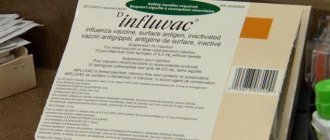When does the vaccination season begin and end?
Flu vaccinations should begin at least 2 weeks before the start of seasonal flu infections.
Most often, the virus attacks in the fall and winter. The incidence usually peaks between December and February in the Northern Hemisphere, and between April and September in the Southern Hemisphere. In Russia, vaccination starts on September 1 and ends in November, when the influenza virus begins to lose ground. At the same time, Russian doctors recommend not waiting for the autumn increase in colds, since after the vaccine is administered, antibodies should be formed that will protect against “wild” viruses. This process takes just two weeks. Thus, the optimal time for flu vaccinations is in September-October, 3-4 weeks before the outbreak.
Increases in the incidence of influenza are sometimes observed in March and even in May. That's why doctors say the vaccination season never ends. According to the World Health Organization, vaccination can be done not only in early autumn, as a planned prevention, but also when the virus has already actively spread. Doctors do not recommend administering the vaccine long before the epidemic (in July, August): its effectiveness may decrease, especially among older people.
Vaccination is carried out only with officially approved vaccines that have proven their safety and effectiveness during trials. Even before releasing a new vaccine to the market, pharmaceutical companies receive a forecast from epidemiologists about which strains of influenza A and B viruses are the most dangerous and are most likely to cause a new epidemic. They will be included in the preparations.
Important! You need to get vaccinated against influenza every year, since influenza A and B viruses quickly mutate, and previously acquired vaccine immunity becomes useless against new strains.
For more information about the strains on which influenza vaccines for the 2020-2021 season were created, read the article “Flu vaccinations in 2020-2021.”
Flu prevention. Vaccination
Prepared by Ekaterina Sergeevna Maltseva, therapist at the 18th City Clinic.
The term "flu" comes from the French gripper (to grab, catch, seize). Previously, influenza was called influenza, from the Old French “to penetrate unnoticed”, “to invade”. This name expresses the suddenness, rapidity of development of signs of the disease, as well as its viral nature - a person “grabs” it, “catches” it. Influenza is an acute infectious disease that primarily affects the upper respiratory tract and occurs with high fever (lasting for 3-5 days), with a pronounced deterioration in health, which is manifested by high fever, severe weakness, severe headache and muscle pain, nausea, and vomiting.
Influenza viruses
People of all ages and at any time of the year get sick with the flu. However, the peak incidence occurs in the autumn-winter period, when people spend more time in closed, unventilated rooms, the body is weakened by a lack of vitamins and is exposed to large temperature changes. Often, influenza diseases turn into epidemics (from the Greek epidemia - general disease). Children become especially susceptible to the influenza virus after six months of life, since by this age they have a decrease in the amount of maternal antibodies transmitted to them in utero, and their supply through breast milk decreases - babies begin to be supplemented, which reduces the frequency of breastfeeding.
The causative agents of this disease are three types of influenza viruses: A, B, C. Influenza viruses have the ability to change quickly, as they constantly circulate among people and exchange genetic material. Many contacts and the development of transport in the modern world contribute to the rapid spread of these viruses in the most remote parts of the world. Severe epidemics of influenza type A occur every 10-40 years, less severe ones occur every 2-3 years. Large-scale outbreaks of type B influenza occur every 4-7 years. Type C influenza diseases occur evenly throughout the year.
If the virus is “captured”
Upon penetration into the upper respiratory tract, the virus (regardless of the type) invades the cells of the outer layer of the mucous membrane, causing their destruction. Cells containing the virus are rejected by the body and enter the environment through breathing, coughing, sneezing, infecting others. This route of transmission is called airborne. Infection is also possible through toys, dishes and other objects of the patient. Within a few days and sometimes hours, the virus, multiplying in the body, causes the first signs of the disease - malaise, chills, aching joints, muscle pain. Then the temperature rapidly rises to 39-40 ° C (some children may develop convulsions against a background of high temperature), dizziness, headache, coughing, sore throat, and a clear and then purulent discharge from the nose appear.
Having had the flu (most often severely), the child acquires immunity to it. However, the problem is that the virus is changing all the time, so that previously developed antibodies (protective specific proteins directed against the pathogen) will not fully protect even someone who has already had the flu from the new variant of the virus.
How dangerous is the flu?
The influenza virus suppresses the body's immune responses, so the child's ability to resist disease is significantly reduced. It is known that during influenza epidemics, the incidence of bacterial respiratory tract infections increases sharply. In addition, the flu causes exacerbation and aggravates the course of chronic diseases (if any). It happens that a child’s chronic illness increases the likelihood of severe influenza and the development of its complications, which are the main cause of high mortality.
Complications of influenza: pneumonia - inflammation of the lungs, otitis - inflammation of the middle ear (sometimes turning into meningitis - inflammation of the membranes of the brain), damage to the cardiovascular and central nervous systems.
Who should get vaccinated against influenza?
The World Health Organization (WHO) recommended vaccination against influenza as the only real way to protect the vaccinated person from this infection and the possibility of creating herd immunity. WHO has identified groups of people who need vaccination (with their consent, of course). This risk group also includes children:
- often sick;
- those suffering from chronic respiratory diseases (for example, bronchial asthma) and/or having malformations of the respiratory system;
- suffering from diseases and/or malformations of the central nervous system;
- with congenital and/or acquired heart defects, heart rhythm disturbances;
- with kidney diseases (chronic glomerulonephritis, chronic renal failure);
- with blood diseases;
- those suffering from endocrine diseases (diabetes mellitus);
- with immunodeficiency conditions;
- children being treated with drugs that suppress the immune system;
- as well as children attending child care institutions.
In Belarus, a list of population groups has been defined that can get a flu vaccine free of charge. These include:
- Children from 6 months to 3 years;
- Children over 3 years of age and adults with chronic diseases;
- Persons with immunosuppression;
- Persons over 65 years of age;
- Pregnant women;
- Medical workers;
- Persons with round-the-clock stay of children and adults;
- Workers of services that ensure the life and safety of society.
Continuous improvement of vaccines
More than half a century of experience in the use of influenza vaccines has made it possible to carefully analyze them and improve vaccine components every year to reduce the already insignificant risk of adverse reactions and complications. The variability of the virus forces scientists to annually analyze the type of pathogen currently circulating and, based on this, determine the composition of the vaccine that will be used. That is, a vaccine that is relevant this season will not be used next year. It was for this purpose that a system of international surveillance of the variability of the virus was created. The problem is that it is impossible to predict with absolute certainty which strain of the virus will cause an epidemic in a particular year. Therefore, if the forecast is accurate, the vaccine will be more effective, and if it is not justified, then it will be less effective, however, in the second case, there will be a positive effect from vaccination, since different strains of viruses have common components. Statistically, vaccination significantly reduces the chances of getting the flu (although it cannot protect against the flu with a 100% guarantee).
Flu vaccines
For specific prevention of influenza, inactivated (not containing live viruses) and live vaccines (containing weakened, non-infectious viruses) are used. The latter are currently practically not used - a new generation of live vaccines is now being intensively developed. Inactivated vaccines have significantly less reactogenicity (the ability to cause complications). To date, three types of such vaccines have been created: whole cell, split and subunit vaccines. They differ from each other in the degree to which the virus is split into its component parts: a whole cell vaccine contains whole cells of the virus, a split vaccine contains all the proteins of the virus (surface, internal), and a subunit vaccine contains only the surface proteins of the virus. Whole-cell and live vaccines can cause post-vaccination complications and therefore have a wide range of contraindications that sharply limit their use. Their only advantage is their good ability to form immunity to influenza.
Split vaccines and subunit vaccines, due to the fact that they do not contain the entire virus, but only its main elements, figuratively speaking, do not contain impurities that can cause complications, are the safest today and are especially well suited for protecting children in their first year of life, and also for children suffering from immune deficiency. Which of these vaccines should you prefer? It is difficult to answer this question categorically, which is why many different studies are being conducted. According to available data, split vaccines are the golden mean. They are able to maximally stimulate the immune system and effectively protect a person from influenza with a low level of adverse reactions.
There are the following types of vaccines for the prevention of influenza - live and inactivated (i.e. killed).
A live vaccine is a vaccine that contains a live vaccine (i.e., specially created for the vaccine) influenza virus.
An inactivated (i.e. killed) vaccine is a vaccine that contains the entire killed influenza vaccine virus or its individual particles (antigens).
Inactivated vaccines, depending on the integrity of the vaccine virus, are divided into: Whole-virion vaccines, i.e. vaccines containing the whole vaccine virus
Split vaccines, i.e. split vaccines containing separate outer and inner parts of the influenza vaccine virus Subunit vaccines, i.e. vaccines containing only the outer particles of the influenza vaccine virus
What do all flu vaccines have in common?
All influenza vaccines provide reliable immunity against influenza disease.
What are the differences between flu vaccines?
| Method of administration | |
| Live vaccines are administered by nebulization using a dispenser | Killed vaccines are administered by injection |
| Age at which vaccinations can be carried out | |
| Live and inactivated whole virion vaccines - from 3 years of age | Split and subunit vaccines - from 6 months |
| Frequency of reactions | |
| When administering live and inactivated whole-virion vaccines, the likelihood of developing reactions is higher than when using split- and subunit vaccines | When using split- and subunit vaccines, the likelihood of developing reactions is lower than when using live and inactivated whole-virion vaccines |
| List of contraindications | |
| General contraindication: allergic reactions to chicken protein | |
| When using live and inactivated whole-virion vaccines, this list is expanded compared to the list for split- and subunit vaccines. It is not recommended to use live vaccines for persons with chronic diseases, immunosuppression, or pregnant women | When vaccinated using split and subunit vaccines, the list of contraindications is minimal |
| List of indications | |
| The list of indications for vaccination with live and inactivated whole-virion vaccines is smaller compared to the list for split- and subunit vaccines | Using split and subunit vaccines, influenza vaccinations can be given to pregnant and lactating women, children over 6 months of age and individuals with a history of certain diseases |
As for vaccination, today in Belarus five vaccines are used to prevent the influenza virus: Chinese Fluvaxin, Russian Grippol, Grippol Plus, Ultravac, French Vaxigrip and Dutch Influvac. Shmeleva and Gribkov were assured that all these vaccines are of high quality and are tested directly in Belarus.
However, they differ in their mode of action. The best immunity against influenza is developed by split vaccines, which contain the influenza virus divided into components - Fluvaxin and Vaxigrip. These are the vaccines that are used to vaccinate people at risk.
The Russian live vaccine Ultravac also creates good immunity, but this vaccine contains weakened live viruses and essentially causes a mild form of the disease. The Grippol, Grippol Plus and Influvac vaccines contain only surface antigens of viruses and are weaker in their effect.
Methods of administering influenza vaccines
All inactivated vaccines are administered as an injection intramuscularly or subcutaneously. The intramuscular route of administration is preferred because it implies better absorption of the drug and, therefore, its greater effectiveness. The subcutaneous route of administration is less preferable because the vaccine remains at the injection site for some time and is slowly absorbed, which in turn affects the rate of formation of protective immunity.
The vaccine is administered intramuscularly into the shoulder (children 18 months and older, adolescents and adults), and subcutaneously - into the subscapular region or the outer surface of the shoulder.
Vaccination scheme
All currently existing influenza vaccines are used according to the standard regimen. The optimal time to start vaccination is September-October, then by the beginning of the epidemic season, which usually occurs in December-January, sufficient immune protection is developed. It is necessary to have time to get vaccinated before the outbreak of the epidemic: if this is done later, the risk of getting vaccinated during the latent (incubation) period of the disease increases.
Children can be vaccinated against influenza from 6 months of age. Children who have not previously been vaccinated and have not had the flu, depending on the vaccine used, are recommended to administer half the adult dose twice with an interval of 1 month. The injection is given intramuscularly or deep subcutaneously. When using vaccines in disposable syringes (syringe-dose), it is recommended to shake the syringe immediately before injection.
Intensive development of a new generation of vaccines that do not require intramuscular administration is currently underway.
Vaccination reactions
Modern influenza vaccines cause relatively few vaccination reactions (a variant of the normal course of the period after vaccine administration). Live vaccines rarely cause a slight, short-term increase in temperature. Inactivated whole cell vaccines can also cause a short-term increase in temperature and swelling at the injection site. Subunit preparations and split vaccines extremely rarely cause weak vaccination reactions in the form of mild soreness at the site of vaccine administration. Considering the weak reactogenic properties of influenza vaccines, their administration can be combined with the use of other vaccines (in different syringes).
When you can't get vaccinated
The main contraindication for the use of the influenza vaccine is intolerance to the components of the drug: chicken egg whites and special preservatives contained in some drugs.
The administration of vaccines in acute diseases or exacerbation of chronic diseases is prohibited. After 3-4 weeks after recovery or subsidence of the manifestations of the chronic disease, vaccination can be performed.
Anti-influenza vaccination is not recommended even if any post-vaccination complications have developed following the previous administration of the drug.
Effectiveness of vaccination
No therapeutic or prophylactic drug provides a 100% guarantee against the disease.
The reliability of the protection formed after vaccination depends on many factors, including the patient’s age and health status, individual characteristics, etc. But on average, out of 100 vaccinated people, 70-98 people will be protected against the flu. If a vaccinated person does get the flu (2-30 people out of 100 vaccinated), then the disease will be mild and without complications. Thus, vaccination guarantees protection against severe and complicated forms of influenza, which can be fatal.
The flu vaccine is designed primarily to protect against influenza viruses, and not against other respiratory viruses. At the same time, the influenza vaccine has additional, to some extent immunomodulatory properties. Thanks to this, the immune system of approximately 20-25 people out of 100 vaccinated acquires additional protection from other respiratory viral infections.
The past epidemic period of influenza incidence in the Republic of Belarus in 2012-2013. was marked by low incidence rates, which was due to an increase in the number of people vaccinated against influenza. An analysis of the results of influenza vaccination conducted in 2012 in the Republic of Belarus showed that the risk of getting influenza among unvaccinated individuals is 4 times higher compared to vaccinated individuals, and the incidence of vaccinated individuals was 74% lower than the incidence among unvaccinated individuals.
Flu vaccination safety
Administration of any vaccines, incl. vaccines to prevent influenza may cause reactions.
The appearance of temperature or redness at the site of vaccine administration is a natural reaction to any vaccine, indicating the beginning of the formation of protection.
After vaccination against influenza, vaccinated people may experience:
- general reactions are reactions that generally affect the body and manifest themselves in the form of increased body temperature, malaise, headache, etc.;
- local reactions are reactions that manifest themselves at the site of vaccine administration in the form of compaction and soreness.
These manifestations are short-term, do not require treatment and disappear on their own within 2-3 days, without affecting the ability to work or requiring additional treatment.
Which flu vaccines are most likely to cause reactions?
General reactions to the administration of live vaccines occur more often: out of 100 people vaccinated against influenza, 8-15 people may have general reactions in the form of increased body temperature (up to 38°C) and general malaise. All these symptoms are short-lived and disappear on their own.
When administering split and subunit vaccines, out of 100 people vaccinated against influenza, 2-8 people may have local reactions in the form of redness, hardness or soreness at the site of vaccine administration, and 1-7 people out of 100 vaccinated may have general reactions in the form of a short-term increase in body temperature (up to 37.5°C), general malaise. All these symptoms are short-lived and disappear spontaneously, usually after 1–2 days.
When should you not get vaccinated against influenza?
There are certain health conditions where the flu vaccine may be temporarily delayed (temporary contraindications) or should never be vaccinated at all (permanent contraindications). In any case, the decision on contraindications is made by the doctor after examining and interviewing the patient.
Temporary contraindications to influenza vaccination include a condition of acute illness or exacerbation of a chronic disease. After normalization of the condition (decrease in temperature and recovery) or transition of a chronic disease into remission, the vaccine can be administered.
A permanent contraindication to influenza vaccination is established extremely rarely, in the case of an immediate allergic reaction in the form of anaphylactic shock, urticaria, Quincke's edema to chicken egg whites (since the vaccine virus is grown on chicken embryos). Such reactions occur in people who, when trying to eat a chicken egg in any form (boiled egg, fried egg, etc.), immediately develop swelling of the lower lip, throat, etc. If there are no such reactions, then flu vaccination is safe for such a person.
Basic recommendations for the prevention of influenza and other acute respiratory infections
Recommendations for the public:
- avoid close contact with people who seem unwell or are coughing;
- avoid or reduce the amount of time you spend in crowded places;
- Practice good hand hygiene: wash your hands frequently with soap and water or use hand sanitizer;
- touch your face with your hands as little as possible, cover your mouth and nose when coughing and sneezing;
- increase the flow of fresh air into living spaces, open windows as often as possible;
- use protective masks when in contact with a sick person;
- adhere to a healthy lifestyle: adequate sleep, balanced nutrition, physical activity, regular walks in the fresh air.
Recommendations for caring for the sick at home:
- isolate the patient from others, at least 1 meter away from others;
- Cover your mouth and nose when caring for patients using masks;
- Wash your hands thoroughly with soap and water after each contact with someone who is sick. Provide separate towels for each family member;
- except for caregivers, the patient should not be visited by other visitors;
- If possible, only one adult in the home should provide care;
- Pregnant women are not recommended to care for the sick;
- constantly ventilate the room in which the patient is located;
- keep the room clean using detergents.
Recommendations for persons with ARI symptoms:
- if you feel unwell, you should stay at home and follow the doctor’s recommendations, if possible, keep a distance of 1 meter from healthy people;
- rest, take plenty of fluids;
- Cover your mouth and nose when coughing or sneezing with a handkerchief or disposable tissues. Dispose of this material immediately after use or wash and iron it. Wash your hands immediately after contact with respiratory secretions!;
- wear a mask if you are in the common area of the house near other people;
- Tell your family and friends about the illness.
Recommendations for parents and guardians:
- Teach children to wash their hands frequently with soap and water for 20 seconds. Parents should also follow this procedure, which will serve as a good example for children.
- Teach children to cough and sneeze into a tissue or, if there is no tissue, into the crook of the elbow.
- Recommend that children do not approach patients closer than one and a half to two meters.
- Sick children should stay at home (not attend preschools and schools).
- refrain from frequent visits to crowded places;
- If your child has been in contact with someone who has the flu, consult your doctor about the need to take antiviral medications to prevent illness.
Materials used:
- https://www.rcheph.by/
- https://otb.by/articles/grip-ori-i-ix-profilaktika
- https://www.who.int/mediacentre/factsheets/fs211/en/
- https://infectology.bsmu.by/_ld/1/164_____-2013-.pdf
- Avian Flu: The Global Threat of a New Pandemic, Mike Davis (2006)
Where can you get vaccinated?
Only health care workers can administer the vaccine, so the number of places where you can get the flu vaccine is limited. As a rule, these are state medical and educational institutions.
Children under 18 years of age must obtain the written consent of one of their parents for immunization. Pregnant women are “vaccinated” only in clinics. Vaccination is recommended for pregnant women, as they are at risk for influenza along with children under 5 years of age and the elderly, however, the first trimester of pregnancy is a contraindication for vaccination.
In major cities
In the cities of Russia, flu vaccinations are received free of charge and on a voluntary basis in adult and children's clinics at the place of residence, in kindergartens, schools, colleges and medical centers of universities. You can contact private medical institutions that also provide vaccination services at home or in the workplace for a fee.
In Moscow
In 2021, in Moscow, everyone will be vaccinated against the flu not only in clinics, but also in mobile centers near metro stations, MCC and railway platforms, as well as in. Before vaccination, you will need to complete a survey and be informed about contraindications and side effects of the vaccine, and have your passport and insurance policy with you. More detailed information about the start of vaccination and its locations can be found on the website of the Moscow Department of Health.
In populated areas without clinics
Residents of villages and villages where there are no medical facilities can also get vaccinated against influenza. For settlements without clinics, mobile vaccination points are provided: doctors go to rural areas to vaccinate local residents.
In educational institutions
Every autumn, an organized flu vaccination campaign takes place in kindergartens, schools and universities in Russia. Before vaccination, you will need to fill out a form and sign an information consent. Just like in a clinic, a medical professional should tell you what drug you are being vaccinated with, what the side effects and contraindications are.
All employees of educational institutions and representatives of certain other professions whose work involves an increased risk of infection are subject to mandatory vaccination. If the vaccine is refused, the employer must suspend such employee from work without pay. For students, vaccination is recommended. A schoolchild or student does not have the right to be suspended from classes, but they can refuse admission to a school or university if there is a threat of an epidemic in the region.
At the place of work
Vaccination at the place of work is usually provided for representatives of professions associated with an increased risk of infection. Among them: agricultural workers, educational workers, medical workers, veterinarians, etc. Military personnel can get vaccinated at work. Some large commercial companies also give their employees this opportunity.
Indications and contraindications for administering the influenza vaccine
Influenza vaccination is recommended for every person over six months old (and some vaccines are also indicated for children over three years old) on the eve of the morbidity season in a particular region. In our country, epidemics occur in winter, and vaccination is carried out no later than November. At the same time, there are categories of people who are in the so-called risk group, and for whom the flu vaccine will be especially recommended:
- persons engaged in working with people - kindergarten teachers and school teachers, health workers, public transport employees and military personnel;
- children over six months old,
- elderly people - over 60 years old,
- persons suffering from chronic diseases are at risk of dangerous exacerbations due to influenza
- persons who often suffer from ARVI.
Contraindications when it is better to refuse the vaccine this season (and sometimes in general) include:
- intolerance to the components of the vaccine;
- acute pathologies - respiratory, intestinal infections or exacerbations of chronic diseases;
- re-vaccination if there was a negative reaction to previous vaccinations or complications appeared;
- pregnancy and lactation period;
- metabolic disorders, such as diabetes mellitus,
- chronic kidney and metabolic diseases;
- in a limited time after meningitis, viral hepatitis, infectious mononucleosis.
How to get vaccinated in a clinic
No special preparation is required before vaccination. On the day of immunization, you need to bring your passport and compulsory medical insurance policy (Fig. 1). Voluntary informed consent is drawn up and signed on site. The instructions are:
- At the clinic at your place of residence, you need to make an appointment with a therapist or infectious disease specialist and check the opening hours of the vaccination office.
- The doctor examines for any contraindications to vaccination.
- If no contraindications are identified, in the vaccination room, on the direction of the doctor, the nurse injects the vaccine intramuscularly into the shoulder.
- Doctors recommend spending the next 15–30 minutes after vaccination in the clinic to make sure there are no unwanted post-vaccination reactions.
Figure 1. Passport and compulsory medical insurance policy - everything you need to have with you to get the flu vaccine in Russia.
Photo: Federal Migration Service of Russia A common reason for medical refusal from vaccination in Russia is the presence of a person’s allergy to chicken protein. The fact is that influenza viruses for many vaccines are grown using chicken embryos. In practice, people with allergies are actively vaccinated with such vaccines without consequences, since the viral proteins undergo thorough purification before entering the drug. However, if you have allergies, it is better to choose a cellular or recombinant vaccine.
How does the vaccine work?
A vaccine is a sample of genetic material (RNA) from a virus that is injected into a person's body. The vaccine does not contain a live virus, but only its fragments, so it cannot harm the body, but it is excellent for preparing the immune system to meet a live virus. The body recognizes fragments of the virus as dangerous foreign elements and forms specific antibodies - proteins, which, when encountering a live virus, can quickly recognize it and block its reproduction. This is why the influenza vaccine is ineffective against other acute respiratory viral infections - each virus has its own RNA, unlike the others.
Vaccination in a private clinic
When visiting a private clinic, you can immediately sign up for vaccination. The doctor's examination before vaccination and the procedure itself take 15–30 minutes. You only need to bring your passport with you.
In the case of a private clinic, you can find out before the procedure which vaccines are available and read their composition. Doctors advise choosing a vaccine that contains antigens (hemagglutinin and neuraminidase) of each strain of the virus in an amount of 15 mcg. In addition, some vaccines protect not against three serotypes of the pathogen (two strains of influenza A and one of influenza B), but against four (two strains of each type).
Information about the composition of vaccines can also be found in the vaccination office. Before vaccination, the doctor should tell you about the need for vaccination and about possible reactions after its administration.
Important! In some private clinics, you can ask to administer a vaccine purchased at a pharmacy yourself. It is important to understand that vaccines must be stored at a certain temperature (from 2 to 8 ℃) and transported correctly. If the patient buys the vaccine himself and then brings it to a medical facility, the risks of violation of the cold regime increase. Therefore, it is better to choose vaccination in a vaccination office.
Popular flu vaccines
Flu vaccines , as is already known, are distinguished by type. But when choosing a specific product, the patient often pays attention to the country of origin, the conditions under which vaccination is carried out, and how the vaccine was stored. You need to trust proven brands, which include:
- Vaxigrip is an inactivated, split vaccine, manufactured by Sanofi Pasteur (France);
- Begrivac - inactivated, split vaccine, Novartis Vaccines and Diagnostics GmbH & Co. KG (Germany);
- Fluarix - inactivated, split vaccine, SmithKline Beecham - Biomed LLC (Russia)
- Influvac - inactivated, subunit vaccine, Abbott Products (Netherlands);
- Agrippal S1 - inactivated, subunit vaccine, Novartis Vaccines and Diagnostics Srl (Italy);
- Inflexal V - inactivated, virosomal vaccine, Berna Biotech Ltd. (Switzerland).
Who should not be vaccinated?
Two of the three types of vaccines can be given to children from six months of age. The latest vaccination is only allowed for people over 18 years of age.
Svetlana Strigunkova emphasized that “there are practically no contraindications for flu vaccination.” An exception is an allergy to chicken egg white. In this case, the vaccine will cause a reaction, since all three varieties are grown in chicken embryos.
A runny nose or sore throat is not a contraindication for vaccination. However, in case of acute acute respiratory infections with high fever, the patient cannot be vaccinated against influenza. The procedure will have to be postponed for two weeks until the patient’s health improves.
When should you get a flu shot?
Doctors advise getting vaccinated against influenza as early as possible. The chief freelance epidemiologist of the Ministry of Health of the Moscow Region, Zinaida Trush, advised residents to get vaccinated from September to November.
The most favorable period for flu vaccination is September and October. It is worth getting vaccinated during these months, because it is during this period that there is no increase in the incidence of ARVI and influenza.
Zinaida Trush.
Immunity against influenza will develop two to three weeks after vaccination. It will not remain with a person forever, but will remain until next autumn. To be more safe, you need to be vaccinated against the virus every year.










